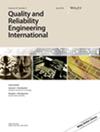A new multivariate gamma process model for degradation analysis
IF 2.8
3区 工程技术
Q3 ENGINEERING, INDUSTRIAL
引用次数: 0
Abstract
In reliability engineering, it is frequently encountered that multiple performance characteristics (PCs) deteriorate simultaneously. The associated degradation processes are usually dependent and exhibit some heterogeneity from unit to unit, which makes the multivariate degradation modeling and reliability evaluation more challenging. To this end, we propose a new multivariate gamma process model. This model introduces a multivariate random vector, whose joint distribution is constructed by marginal gamma distributions and a copula function, to describe the unit‐to‐unit variability and the dependence among PCs. Meanwhile, it does not require all PCs to be inspected at the same time points in contrast to the traditional copula‐based degradation models. In addition, two reliability evaluation methods are developed. Model parameters are estimated by the stochastic expectation maximization algorithm, and a three‐step procedure is provided to initialize this algorithm. Subsequently, numerical simulations are implemented to verify the proposed methods. Finally, two examples are provided for illustration, and it is shown that the proposed model and methods scale well to the degradation data with different numbers of PCs. What is more, comparisons with several benchmark models are performed, and the superiority of the proposed model is well demonstrated.用于降解分析的新型多元伽马过程模型
在可靠性工程中,经常会遇到多种性能特征(PC)同时退化的情况。相关的劣化过程通常具有依赖性,并且在不同单元之间表现出一定的异质性,这使得多变量劣化建模和可靠性评估更具挑战性。为此,我们提出了一种新的多元伽马过程模型。该模型引入了一个多变量随机向量,其联合分布由边际伽马分布和 copula 函数构建,用于描述单元与单元之间的变异性和 PC 之间的依赖性。同时,与传统的基于 copula 的退化模型相比,它不要求在同一时间点对所有 PC 进行检测。此外,还开发了两种可靠性评估方法。模型参数通过随机期望最大化算法进行估计,并提供了一个三步程序来初始化该算法。随后,通过数值模拟来验证所提出的方法。最后,提供了两个示例进行说明,结果表明所提出的模型和方法能很好地扩展到不同 PC 数量的降解数据。此外,还与几个基准模型进行了比较,充分证明了所提模型的优越性。
本文章由计算机程序翻译,如有差异,请以英文原文为准。
求助全文
约1分钟内获得全文
求助全文
来源期刊
CiteScore
4.90
自引率
21.70%
发文量
181
审稿时长
6 months
期刊介绍:
Quality and Reliability Engineering International is a journal devoted to practical engineering aspects of quality and reliability. A refereed technical journal published eight times per year, it covers the development and practical application of existing theoretical methods, research and industrial practices. Articles in the journal will be concerned with case studies, tutorial-type reviews and also with applications of new or well-known theory to the solution of actual quality and reliability problems in engineering.
Papers describing the use of mathematical and statistical tools to solve real life industrial problems are encouraged, provided that the emphasis is placed on practical applications and demonstrated case studies.
The scope of the journal is intended to include components, physics of failure, equipment and systems from the fields of electronic, electrical, mechanical and systems engineering. The areas of communications, aerospace, automotive, railways, shipboard equipment, control engineering and consumer products are all covered by the journal.
Quality and reliability of hardware as well as software are covered. Papers on software engineering and its impact on product quality and reliability are encouraged. The journal will also cover the management of quality and reliability in the engineering industry.
Special issues on a variety of key topics are published every year and contribute to the enhancement of Quality and Reliability Engineering International as a major reference in its field.

 求助内容:
求助内容: 应助结果提醒方式:
应助结果提醒方式:


